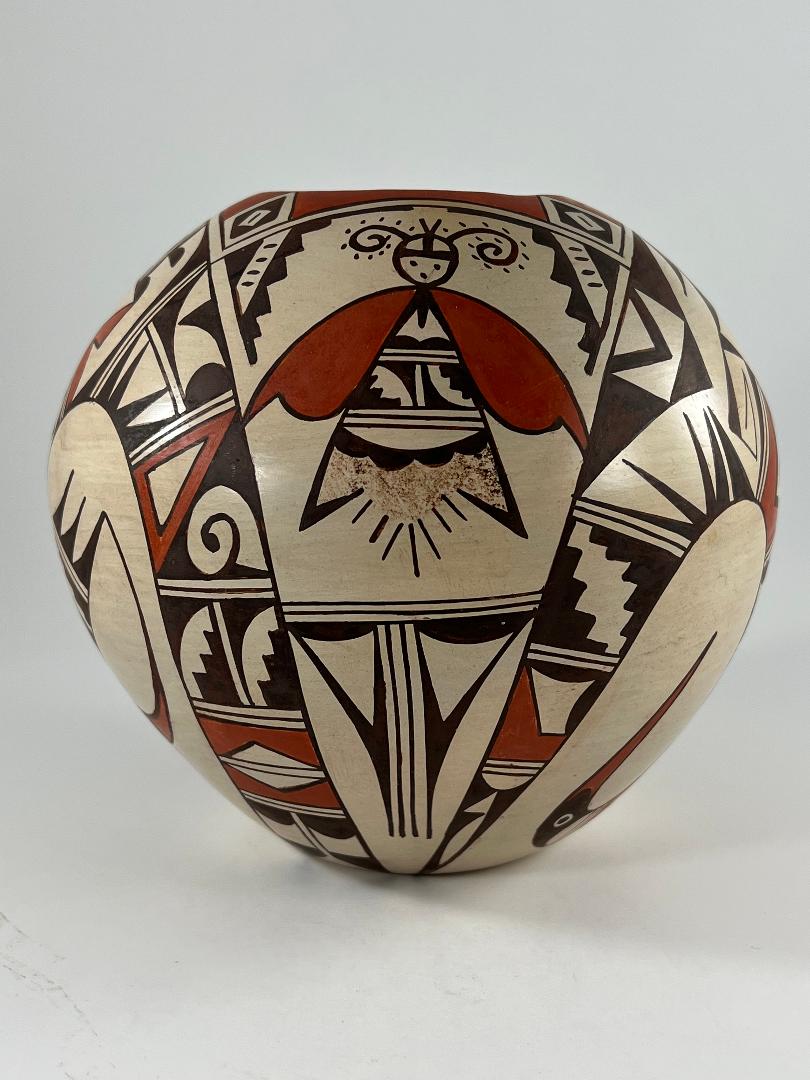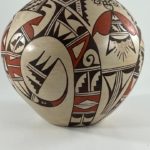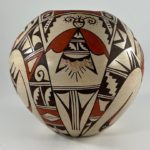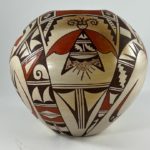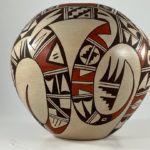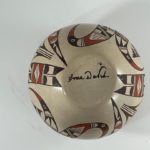Irma David’s pottery designs are often curvilinear with gaps between the elements. On this jar she has created space in her design to insert butterflies on opposite sides of the pot. Her designs are distinctive, perhaps because the dense curved designs create a great deal of energy and yet the residual spaces frame the elements.
Form:
From a wide 2.25-inch base the pot slopes outward for about 3 inches, then gently curves inward another 4 inches to the lip of a 2.25-inch mouth. Although the vase is wider at the top than the bottom, it visually sits solidly on a table top, perhaps because the base and mouth have the same dimension. The walls are even and about 2 inches of the surface inside the mouth are stone polished. Horizontal polishing striations on the outer surface are barely visible. The surface of Irma’s pots fire a light grey, except that one patch around the head of one of the butterflies has an orange blush from the outdoor firing.
Design:
The design is complex, but more structured than a first glance might indicate. A 2.8125″ by 3.0″ red rectangle surrounds the jar’s mouth. Set into each corner is a black diamond at the center of an unpainted diamond shape. At the center of the black diamond is an unpainted rectangle, and at its center is a single short black line. Two thin framing lines border the large red rectangle.
Take an imaginary knife and, starting at the edge of the red rectangle, slice two of these parallel framing lines downward at an angle, thus cutting the pot into three pieces. Chose the framing lines so that when you cut the pot, the two butterflies remain together on the center slice. Were you to lay the three pieces of pot on a table, you would notice that the outer two slices have the same design pattern while the center butterfly slice is wedge-shaped. Having dissected the vase, I will discuss the design referring to “the outer slices” and the “the center wedge.”
The outer slices:
Along the edge of these shards is a great arc of design 14.5-inches long. The points of the arc touch the base of the jar. Most of the band of design is about an inch wide, but the last 4 inches of the left side narrow to a point. There are 11 segments of design in the arc, though some segments are subdivided. Three segments are red, the rest black. The element on left (wide) end of the arch is in the form to two linear tails with black tips. The element on the left (pointed) end resembles the head of a bird, though it lacks eyes and instead contains two unpainted forms. Thus the the arc is generally, but not specifically, in the form of an abstracted bird.
At the apex of the arc is a square section with an unpainted background. In two corners of this square are black dots. Diagonal between them are elements that look like two flights of stairs, with their smooth side facing the dotted corners and the steps facing each other. Thus the residual unpainted gap between the stairs is a sawtoothed diagonal.
To the right of this apex section is a rather narrow section that is black with an embedded unpainted element. To the left of the apex section is a considerably wider section, also black with embedded unpainted elements. Each of these flanking sections serves as the base for pendant designs that are abstracted birds. The bird growing out of the narrow base curves counterclockwise to the left. The bird growing out of the wide base curves clockwise to the left. The curved backs of these birds touch as they arch downwards. Each bird has six sections of design, three red and three black.
As the bird to the right curls, it encloses an unpainted circular area. Pendant from the tip of the beak of the bird is a set of black elements floating in this unpainted space. First are three conjoint fins, the tip of the right fin attached to the beak. Below is an unpainted strip with a single line down its center, its far edge serving as the base of a set of stairs. Attached by a thin line, a second set of stairs floats in space below.
The pendant bird to the left encloses an unpainted oval area and its narrowness prevents the drawing of elements floating in that space.
The center wedge:
The center wedge is horizontally divided into two sections. The top section occupies just under half the vertical length of the wedge but visually dominates its surface. In part this visual prominence is due to the width of the top section, in part because the point of the lower section cannot be seen when the vase is on a table. The vertical edges of the wedge are not edged in black but are formed by the bodies of the avian forms that sweep in from the outer slices of design.
The top corners of this central wedge are occupied by large, black, kiva step forms. Cut diagonally across their triangular body is an unpainted diagonal containing four short lines. The rest of this upper section is filled with the image of a large red-winged butterfly.
The heads of the butterflies are round circles, mouths and eyes represented by simple dots. Above the eyes the forehead is indicated by a horizontal line bisected by a vertical line, an inverted “T.” This creature carries two kinds of antennae. From the center of the head are two single-strand feelers; they are bracketed by larger curlicue antennae with 10 to 12 lines or dots on their edges.
The body of the butterflies is a black-edged wedge filled with unpainted designs set against a black background. The upper point of the wedge carries an unpainted triangle, with a single line hanging from its apex. I had not known butterflies could wear neckties. On the base of this unpainted space are two small conjoint hills (“gumdrops”). The core of the butterfly body is bounded, above and below, with sets of three parallel lines, two-lane “highways.” A vertical single-lane highway connects the two-lane highways, thus dividing the body core into two sections. Inset into each section is a small unpainted lunette with a stepped edge. Based against the lower two-lane highway, an unpainted lunette projects downward into the next section. Its lower edge is a thick black arc composed of four conjoint “gumdrop” hills. The black edged triangle that demarcates the butterfly’s body does not have a flat bottom. Instead its lower edge is broken with each end bent upward to form a “V” shape, leaving the center of the body open. Spilling out of this gap is a stippled element with a curved edge emitting 6 or 7 rays, as if the butterfly was giving birth to the sun.
The lower section of the central wedge carries a simple design. The two-lane highway marks its upper boundary. At right angle is a three-lane highway that bifurcates the space. At the top edge of each section is a wide black hill, its base on the highway above. Below, with their points in the corners of each section hang large “V” shapes that grow thicker as they descend, ending in elongated, substantial points.
Design analysis:
The pot is very well formed, the walls even, a bit thin and yet sturdy enough to keep the pot intact. Nobody except those who are manic would notice that the first few inches inside the mouth of the jar are polished. The external polishing is so fine that polishing striations are all but invisible. A careful master potter was at work here.
Color is effectively used to integrate the design. The expansive red around the mouth of the jar visually associates with the broad red wings of the butterfly below. About a dozen red elements occur elsewhere. No matter how you turn the jar, 5 or 6 red elements are visible, encouraging a viewer’s eye to gaze at the full range of design.
Small details also help the design cohere. Conjoint hills mark both the top and bottom of the butterfly’s core. Every view of the jar’s surface will include some version of the kiva-step element. The “V” shapes that frame the rear of the butterfly are reproduced directly below in larger format. For most observers these linkages are subliminal, but they are there and increase the visual impact of the design.
Irma is extraordinarily accurate in her painting. If you could actually lay the outer slices out side-by-side you would find only two differences in design. The curled butterfly antennae in one rendition carry a series of short lines; on the other butterfly these antennae are surrounded by dots. On one side the stippled sun emerging from the rear of the butterfly has 6 rays; the second version has 7 rays. Since Irma could not see one side while she was painting the other, her accuracy of design is extraordinary.
The design is crowded with avian images and those two butterflies, which I think is not an accident. Birds carry Hopi prayers for rain to the gods. When such prayers are answered, the wet desert blooms with flowers and butterflies. I don’t know what Irma was thinking when she painted this vase, but the iconography has deep roots in Hopi culture. Jar 2021-10 may be both a prayer for rain and a representation of the beauty that results when such prayers are answered. Like jar 2021-05, Irma David’s work brings these blessings into my home, and I am grateful.

